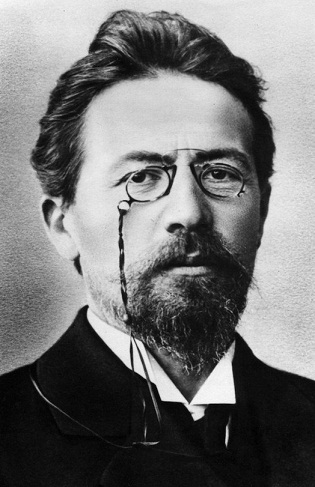Anton Chekhov (Anton Chekhov)

Author. Russia’s greatest dramatist and short story writer, he had a seminal influence on 20th Century literature. Chekhov was born in Taganrog, the grandson of a former serf who had purchased his freedom. His father, a grocer and domestic tyrant, went bankrupt in 1876, and to avoid debtor’s prison he fled to Moscow with most of the family. Young Anton was left behind to fend for himself. He managed to win a scholarship to study medicine at Moscow University and rejoined his family in 1879. To alleviate their poverty he began selling jokes and satirical sketches to periodicals written under several pseudonyms, the most frequent being Antosha Chekhonte. His first collection, “Tales of Melpomene”, was published in 1884, the year he became a practicing physician. While he liked to claim that “Medicine is my lawful wife, and literature is my mistress”, he never made much money as a doctor and treated the poor for free. Chekhov’s early writings were mostly popular ephemera – “Oh, with what trash I began”, he lamented at the end of his life – though stories such as “A Living Chattel” (1882) and “Misery” (1885) offered hints of what was to come. Encouragement from authors Nikolai Leskov and Dmitry Grigorovich was followed in 1886 by his introduction to Alexei Suvorin, Russia’s most powerful publishing magnate. Suvorin not only agreed to bring out his work under very favorable terms but became one of his few intimate friends. From then on Chekhov produced more carefully crafted stories under his own name. The appearance of the prize-winning story collection “At Twilight” (1887), the masterful long tale “The Steppe” (1888), and the play “Ivanov” (1887, revised 1889) put him firmly in the front rank of Russian writers. In 1890 he made an arduous 6000-mile trek to the Far East to investigate the Sakhalin penal colony, reporting his findings in a series of essays later published as his only nonfiction book, “The Island of Sakhalin” (1895), but overall he left muckraking to others. Soon after his return he bought the small country estate of Melikhovo, 40 miles south of Moscow, where his efforts as a district physician largely spared the region from the cholera epidemic of 1893-1894. He also built schools for the local peasant children. During this period Chekhov produced most of his finest mature stories, among them “Gusev” (1890), “The Duel” (1891), “Ward No. 6” (1892), “The Black Monk”, “Rothschild’s Violin” (both 1894), “My Life” (1896), “Peasants” (1897), “Ionych” and the trilogy “The Man in the Case”, “Gooseberries” and “About Love” (all 1898). His first major play, “The Seagull” (1896), was a fiasco at its St. Petersburg premiere; but its 1898 revival by the new Moscow Art Theatre, directed by Konstantin Stanislavsky, was a triumph that established the MAT’s reputation and naturalistic method. (To this day a seagull serves as the company’s logo). The MAT premiered Chekhov’s subsequent classics “Uncle Vanya” (1899), “Three Sisters” (1901), and “The Cherry Orchard” (1904). Sadly, his ascendance as a playwright of genius coincided with the decline of his health. As early as 1884 Chekhov suspected he had tuberculosis, and he neglected it. In March 1897 he suddenly collapsed at a Moscow restaurant and learned he was terminally ill with the disease. On the advice of his doctors he moved to the Black Sea resort city of Yalta, settling into a new villa he built in 1899. Despite his bleak prognosis – or perhaps because of it – the lifelong bachelor embarked on a romance with MAT actress Olga Knipper, with whom he had fallen in love during rehearsals for “The Seagull”. They married in 1901. By mutual (albeit unhappy) consent the relationship was marked by long separations, with Knipper continuing her career in Moscow while Chekhov remained in Yalta. They exchanged hundreds of letters, in which the author affectionately called his wife “My Doggie” and urged her to fight Stanislavsky over the staging of his plays. He wrote little fiction in his last years but it includes two masterpieces, “The Lady with the Dog” (1899) and “In the Ravine” (1900). In June 1904 Knipper took Chekhov to a health resort in Badenweiler, Germany, where he died the following month. He was buried next to his father at Novodevichy Cemetery in Moscow. Chekhov’s 600-odd stories and 14 plays offer a vast panorama of life in pre-revolutionary Russia. As a doctor he had contact with all levels of society, and as an artist he had no illusions about any of them. The originality of his style that baffled older contemporaries like Leo Tolstoy was rooted in his need for dispassionate honesty and conciseness. He once told a friend, “It seems to me that when you write a short story, you have to cut off both the beginning and the end. We writers do most of our lying in those spaces”. He rejected formal plots, refused to moralize or judge, and replaced rhetoric and high-flown ideals with understatement and the inconsequentiality of everyday existence. His late dramas are no less radical, ensemble mood pieces that unfold through inaction, anticlimax, and the delineation of character through incident. Ironic humor is not absent – Chekhov started out as a satirist, after all – but what keeps his work alive and meaningful today is its clear-eyed humanity. For many Chekhov is the world’s first truly modern author. (bio by: Bobb Edwards) Family links: Parents: Pavel Yegorovich Chekhov (1825 – 1898) Spouse: Olga Knipper (1868 – 1959)Cause of death: Tuberculosis
Born
- January, 29, 1860
- Russia
Died
- July, 07, 1904
- Germany
Cause of Death
- Tuberculosis
Cemetery
- Novodevichy Cemetery
- Russia

